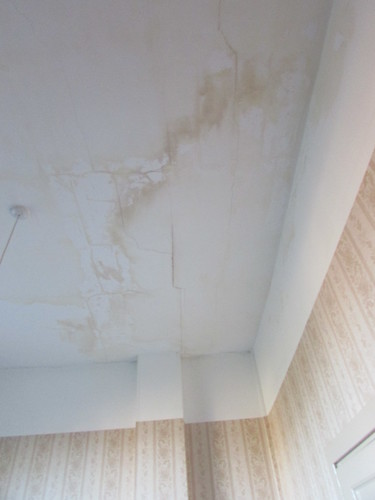With no cold feed to the system, hot water and the central heating could not be used and, with a number of ceilings and walls thoroughly wet, I was a bit circumspect about using electricity as well. I'm usually rather grumpy about the house insurance premiums I'm invited to pay but, for once, I was delighted to find that the insurers had supplied an emergency number to ring in these circumstances. They were a bit apologetic that they were having a very busy time but, within a few hours, an emergency plumber arrived (who'd come from a base in Runcorn, 70 miles away). Within minutes, the offending split copper pipe had been removed and replaced with plastic pipe and fittings.

Brewood Hall Burst Water Pipe: Detail of the split half-inch copper pipe which caused the trouble after removal.
Further telephone calls established the beginnings of a plan. The insurers were anxious to first install temporary de-humidifiers to start drying out affected areasI enlisted the help of our builders, A. M. Griffiths, to advise on what would be required and the insurers authorised the hire of two industrial de-humidifiers which were delivered and, with a lot of effort, manhandled into place, initially with one on the second floor, one on the first floor. Being intended for industrial use, both units were for operation from 110 volts a.c., requiring hire of industrial 240/110 volt isolating transformers. The two units were of different types but similar capabilities. In each, the water extracted was delivered through a short hose into 5-gallon plastic containers which initially required emptying with rather disconcerting frequency. With two large de-humidifiers running continuously, it was rather noisy. After a few days, the volume of water extracted reduced and the de-humidifiers were relocated, one to cover another part of the first floor, the other to start work on drying the ground floor.

Brewood Hall Burst Water Pipe: Hired-in industrial de-humidifier used to dry-out the affected areas, shown in use on the first floor.

Brewood Hall Burst Water Pipe: Hired-in industrial de-humidifier used to dry-out the affected areas, shown in use on the ground floor. Note the yellow 240/110 volt transformer
The leak had been in one room on the second floor but, once under the floorboards of that room, water had been able to flow sideways so as to affect a number of rooms, a landing and a stairwell on the first floor. On the ground floor, the damage appeared to be confined to the stairwell and the large kitchen. The local decorator I'd used before came in every day to check the moisture content of the affected plaster-finished walls with a hand-held electronic tester and after a few more days, periodically adjusting the position of the de-humidifiers, only small amounts of water were being extracted and measurements indicated that sufficient dryness had been achieved. The house seemed very quiet with the de-humidifiers switched off.
The insurers arranged a visit by an electrician to check the installation for water damage. To my surprise, electrical damage appeared to be confined to one light fitting. It was now possible to obtain estimates for repair and re-decoration and the insurers approved the estimate from the local decorator. Immediately after the leak, I'd frantically moved pictures and smaller items of furniture out of harm's way so there didn't appear to be damage there. The main cost was remedial work to ceilings, walls and one area of floorboards, together with redecoration of ceilings and walls in a nuumber of areas.

Brewood Hall Burst Water Pipe: Ceiling damage in the rear Bedroom, some distance away from the leak

Brewood Hall Burst Water Pipe: Wall damage in the Servants' Passage, after removal of pictures

Brewood Hall Burst Water Pipe: Water damage to lath and plaster ceiling and walls in the Servants' Passage, looking towards stairwell.

Brewood Hall Burst Water Pipe: Water damage to the ceiling in the Victorian Sitting Room, also affecting the floor.
Once the decorator had finished, the appearance of the affected area was restored substantially to their appearance before the burst occurred. A distressing experience but as nothing compared with the heartbreak of the increasing numbers of people who find their homes completely inundated by flooding as weather patterns appear to change. And, in this case at least, the insurers responded promptly to indemnify me for the damage.
My posts about Brewood Hall
You can find all my posts about Brewood Hall here (in reverse date-of-posting order), with links to albums of pictures.
My Pictures
Pictures in this post can be viewed uncropped, where necessary, by clicking on the image. Selecting from the full 2021 album below allows viewing or downloading in various resolutions:-
Brewood Hall Burst Water Pipe
